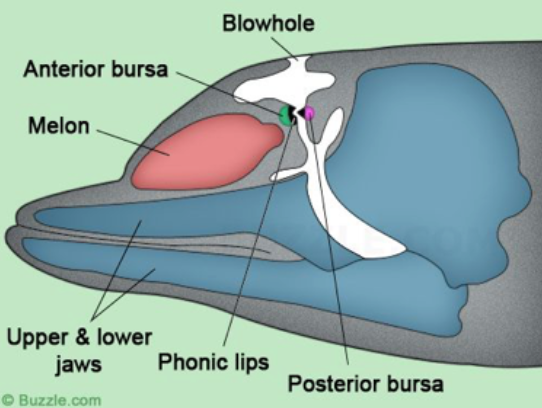Dolphin Communication
Written by Asiyah | Edited by Hitej | November 12th, 2023 | Science
Did you know that humans are not the only species that can communicate? Many animals can, but dolphins have one of the most advanced communication skills. They have many ways to communicate, not only by sound, but also by movements and actions. We will talk more about how dolphins emit sound and echolocation. Well, what are we waiting for? Let’s dig deeper into the world of dolphin communication.
How Do Dolphins Emit Sound?

Image Credit: Buzzle
As you can see in the diagram to the left, several structures allow a dolphin to make sounds. In the air, dolphins emit sounds by letting out air through their blowholes. They have muscles that can change the shape and size of their blowhole to make different sounds. Underwater, dolphins depend a lot on sound to find both food and their way through the ocean. They also use it, of course, to communicate with other dolphins. The sounds come from inside the dolphin’s head, below its blowhole, and usually without air coming out from its blowhole.
Two main theories attempt to explain how the dolphin emits sound underwater. The first one, called the nasal sac theory, is that the dolphin takes a breath, closes its blowhole, and air comes back from the dolphin’s lungs into a channel that leads to the dolphin’s closed blowhole, and to one or more air sacs.
Echolocation
Conclusion
In conclusion, dolphin communication is a broad topic and more interesting than it seems. Dolphins use a range of communication skills, from sound emission to movements, to “talk” to one another, and they also use echolocation to find food and stay away from danger. We still don’t know exactly how they communicate, and there’s so much more to explore! Maybe this weekend you can do some more research and see what else you can learn about these amazing creatures.
Sources
- How Dolphins Make Sounds: https://dolphins.org/acoustics
- How Dolphins Communicate: https://us.whales.org/whales-dolphins/how-do-dolphins-communicate/
- Study on Mother-Calf Communication: https://assets.speakcdn.com/assets/2871/kuczaj_et_al_2009_gotta_go.pdf
New to Pearson Online Academy? Learn More Here.
